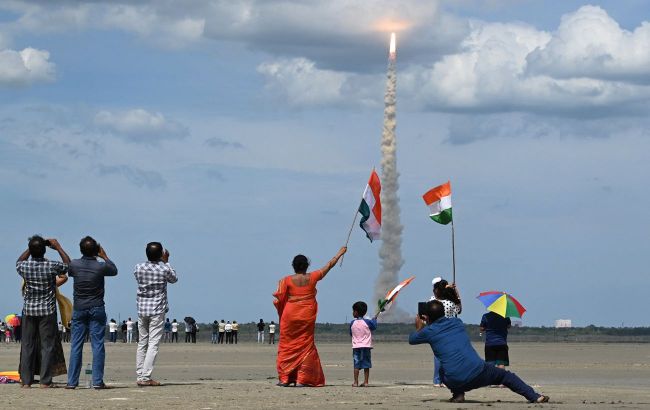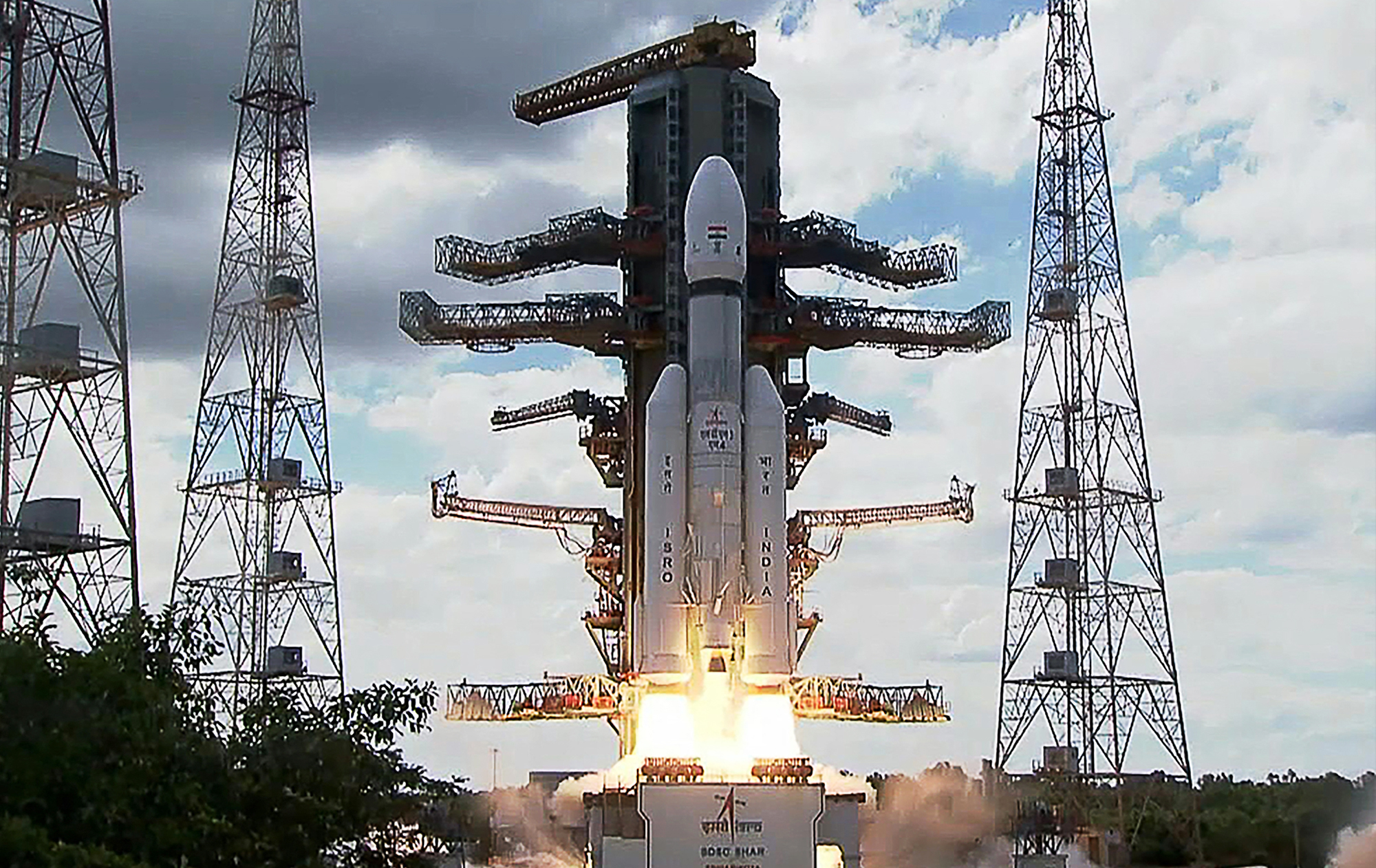Battle for the Moon: How Russia's setback and India's triumph could shift space exploring landscape
 Photo: More than a month passed from the Chandrayaan-3 launch to the landing (Getty Images)
Photo: More than a month passed from the Chandrayaan-3 launch to the landing (Getty Images)
This week, Russia lost the battle for the title of the world's first country to land on the southern pole of the Moon. Its mission failed even during the pre-landing stage, while today, on August 23, India successfully landed its spacecraft.
RBC-Ukraine provides more details about the Indian mission and the space failure of Russia.
What's known about the Chandrayaan-3 mission
Chandrayaan-3 is the third automatic interplanetary station (AMS) by the Indian Space Research Organization (ISRO). The mission was launched on July 14 from the spaceport on Sriharikota Island.
Three weeks later, the spacecraft entered lunar orbit, and on August 17, the landing module separated from the flyby module. Today, this module, along with the Pragyan lunar rover, touched the surface of the Earth's satellite.
The landing module, around 2 meters tall and slightly over 1700 kg in weight, is equipped with:
- The RAMBHA Langmuir Probe for plasma research.
- The ChaSTE tool for thermal and physical surface studies (measuring soil thermal conductivity).
- The ILSA (Instrument for Lunar Seismic Activity) three-component seismic instrument.
- LRA corner reflectors for lunar laser location, provided by NASA.
The Pragyan six-wheeled lunar rover will communicate only with the landing module. The 26 kg rover is equipped with two front navigation cameras and two scientific instruments: the LIBS laser spectrometer (to determine rock composition by analyzing emitted substances' spectrum) and the APXS - Alpha particle X-ray spectrometer (for determining soil and rock composition using X-ray fluorescence).
As expected, Chandrayaan-3 will operate for two weeks. The station will conduct a series of experiments, including spectrometric analysis of the lunar surface's mineral composition.
Initially planned for 2020, the launch date was repeatedly postponed. The project's cost is estimated at $90 million. Notably, India became the fourth country in the world, following the United States, USSR, and China, to achieve a soft landing on the Moon.
Previous attempts
India launched its first Chandrayaan-1 mission in 2008. It was a station weighing 1300 kg and had a cube-resembling shape with sides of 1.5 meters. It carried a dozen instruments: 6 from India, 6 from the European Space Agency, NASA, and the Bulgarian Academy of Sciences for precise measurement of space radiation around the Moon.
Chandrayaan-1 was launched to search for valuable minerals and ice reserves in the Moon's polar regions, as well as to create a three-dimensional map of the surface.
As part of the program, the Moon Impact Probe equipped with a mass spectrometer, altimeter, and video camera was also launched. Data from its tough landing was used to calculate the current module's final trajectory.
In the Chandrayaan-2 mission in 2019, India attempted to soft-land a spacecraft. However, communication was lost a few minutes before landing.
"We came very close, but we need to cover more territory. Our determination to touch the Moon has become even stronger," said India's Prime Minister Narendra Modi at that time.
What's the reason for flying to the Moon
Another space race is unfolding over the Moon's southern pole, though it greatly differs from the Cold War rivalry between the United States and the USSR.
Currently, the United States, China, Russia, and India are striving to establish their presence there. It is believed that there are ice reserves in the lunar soil near the southern pole. It needs to be determined whether these reserves can provide water and fuel for future expeditions. The components of water - oxygen and hydrogen - can be used as rocket propellant.

Photo: India's current mission is the third one (Getty Images)
The US intends to send humans back to the Moon in 2024 or 2025 as the Artemis program is in its final stages. China also plans to send a manned spacecraft a few years after the Americans.
Moon missions highlight the two most critical moments - Earth launch and Moon landing. In the past four years, there have been three attempts. India's Chandrayaan-2, as well as spacecraft from Israel's non-profit organization and a Japanese company, successfully maneuvered in lunar orbit but faced failures during the downing to the surface.
Russia's preparation stretched for decades
The Russian interplanetary station project began in 1997. The launch was initially planned for 2000 but was repeatedly delayed for various reasons. From the start, the project faced technical and financial issues.
In 2005, the project was named as Luna-Glob. The spacecraft was designed on the basis of the Phobos-Grunt, intended for a landing on Phobos, Mars' natural satellite. In 2011, shortly after launch, the engines failed, and the spacecraft crashed into the Pacific Ocean. This led to a reconsideration of the "lunar policy," and the project was renamed Luna-25.
The name signifies continuity with the Soviet space program: the last previous automated station, Luna-24, was launched to the Moon in 1976. The Luna-25 launch was initially planned for 2014 but was postponed due to Western sanctions related to the annexation of Crimea and the war in Donbas. These restrictions deprived the AMS of the European navigation camera Pilot-D, crucial for practicing precision landing for future missions.
A few weeks after the full-scale invasion of Ukraine in 2022, Russian President Vladimir Putin announced the revival of the lunar program. He aimed to respond "to the challenges of space exploration and derive its benefits on Earth."
As a result, Russia launched the interplanetary station from the Vostochny Cosmodrome (Amur region) on August 11, 2023, 47 years after the Soviet Luna-24.
Failed attempt to outshine India
The Russian mission included four components: the Luna-25 lunar lander, the Soyuz-2.1b launch vehicle, the ground control complex, and the ground-based scientific complex.
Initially, the mission planned to send a descent module first and an orbital module a few years later. The Luna-25 landing module was intended to explore the southern pole, searching for water using cryogenic drilling up to two meters deep. The claimed operational lifespan was at least one year.
During the launch, the carrier rocket operated normally, placing the spacecraft on the flight path toward the Moon. It entered lunar orbit on August 16 and managed to send several images, including the Zeeman South Polar crater.
 Photo: An image of the Moon's surface from the Russian spacecraft (t.me/roscosmos_gk)
Photo: An image of the Moon's surface from the Russian spacecraft (t.me/roscosmos_gk)
Two days later, the engines performed an orbit correction to achieve optimal conditions for the pre-landing trajectory. However, on August 19, communication was lost. This followed another correction during which an "abnormal situation" occurred.
Efforts to restore communication were unsuccessful, and Luna-25 crashed at a speed of 1.7 km/s. Preliminary data indicated it impacted the 42-kilometer Pontécoulant G crater in the southeastern limb of the visible side of the Moon's southern hemisphere.
Causes of the failure
According to some data, the calculated parameters for Luna-25 deviated from the nominal ones even before transitioning to the pre-landing orbit. It's quite likely that postponing the transition could have saved the spacecraft.
Russian media, citing various Telegram channels, suggested that the spacecraft might have received a braking impulse that was 1.5 times higher than the calculated value, leading to a collision with the surface.
Yuri Borisov, the head of Roscosmos (Russian state space company), explained that Luna-25 crashed because the engine didn't shut down on time.
"The engines that were supposed to correct and put the vehicle on the pre-landing orbit activated. Unfortunately, the engine shutdown happened not in the standard manner according to the cyclogram but based on a time delay," he noted.
As a result, instead of the required 84 seconds, the engine operated for 127 seconds, causing the spacecraft to "enter an open lunar orbit" and collide with the Moon's surface. The reasons for the engine's abnormal operation are being investigated.
 Photo: Russia is still investigating the reasons for the Luna-25 collapse (t.me/roscosmos_gk)
Photo: Russia is still investigating the reasons for the Luna-25 collapse (t.me/roscosmos_gk)
Another reason, according to Borisov, is the nearly 50-year break after the launch of the last Soviet mission. Nevertheless, he believes that despite the failure, Russia gained "invaluable experience" in lunar flight and orbiting.
How the space exploring landscape will change
The race for the Moon's South Pole involves not only scientific achievements and national prestige but also money. The success of the Chandrayaan-3 mission is expected to trigger significant growth in India's space sector, which is still in its infancy.
At the initiative of Prime Minister Narendra Modi, the country intends to open this sector to foreign investment, aiming to increase its market share in space launches by five times over the next decade. Now, the Indian sector will benefit from the reputation of being competitive engineers.
For comparison, NASA plans to spend around $93 billion on the Artemis lunar program.
"The moment this mission is successful, it raises the profile of everyone associated with it. When the world looks at a mission like this, they aren't looking at ISRO in isolation," Reuters cited Ajey Lele, a consultant at New Delhi's Manohar Parrikar Institute for Defence Studies and Analyses.
Despite the fact there are no guarantees for essential resources at the Moon's South Pole, India can reap other rewards. It now has the opportunity to establish itself in space.
According to former Pentagon employee and Senior Fellow at the American Foreign Policy Council, Peter Garretson, the world has always viewed India as a junior spacefaring state, but the stakes have risen.
"If India can succeed where Russia has failed, it signals a new pecking order in space. It will signal an arrival of sorts on the global stage and change the perception of India … ‘looking up’ to Russian achievements and technological know-how," Politico quotes the expert.
A crucial advantage is being drawn into the space market. In July, India became the 26th signatory of the Artemis program, which involves close collaboration between space agencies and companies worldwide — except Russia.
Roscosmos says it will push forward with Luna-26 and Luna-27 launches, but experts doubt they can finance these missions. The budget had been shrinking even before the full-scale invasion of Ukraine. Under Moscow's current priorities tied to the war, further Moon launches appear highly unlikely.
"The mission’s (Luna-25) failure may be a blow to President Vladimir Putin, who has used Russian achievements in space as part and parcel of his hold on power. That is part of the Kremlin’s narrative — a compelling one for many Russians — that Russia is a great nation held back by an American-led West that is jealous of and threatened by Russia’s capabilities," The New York Times writes.

